Many of us predicted that this would be the top marketing question of 2025.
Well, here we are and here it is. It’s time to adapt.
It’s an important, interesting and difficult question. But a few clear strategies have emerged. Here is a simple, practical approach to increase visibility in AI. Your goal is to improve the chance of mentions for your brand when your future prospects ask for a recommendation from AI.
Note: Marketers haven’t yet settled on a term for this new practice. It’s variously called AIO, AEO, GEO or just SEO. I’ll use the term “AI optimization” for now.
1. On-site AI optimization
Pop open your favorite AI and ask it about your brand with a prompt like “Tell me everything you know about [Your Legal BrandName]”. Look at the sources. If the sources are from your website, that’s all the confirmation you need that Learning Language Models (LLMs) are training on your brand.
But does your site provide complete training data? Does it include all of the details necessary to help guide the user toward your brand? Does it clearly state who you help?
Remember, this isn’t traditional SEO with short queries. Prompts are often 5x longer than queries (source). Your future prospect is having a conversation with the AI. It’s probably that they are telling it who they are, what their problems are and what specific outcomes they are hoping to achieve.
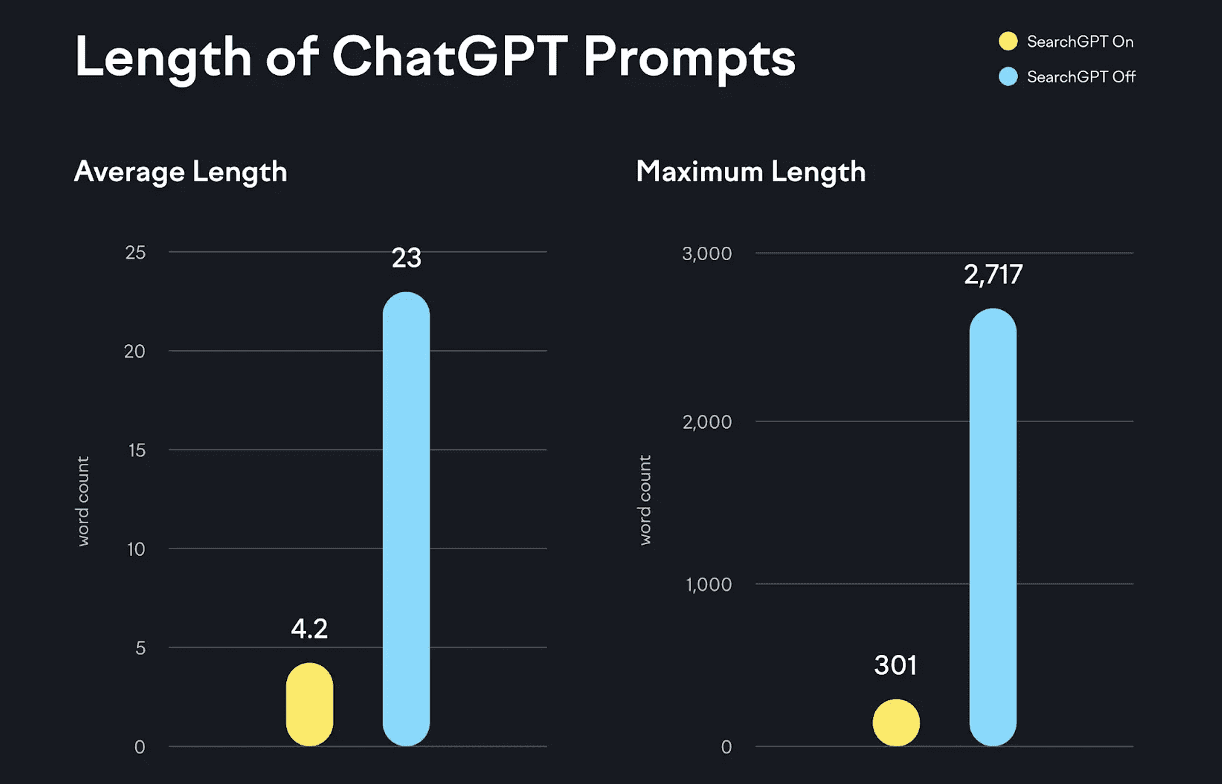
So your job as an AI optimizer is to make sure that your site is complete. We could call this “on-site AIO.” It’s not about keywords, it’s about a complete business brief. An executive summary that explains how your business fits in the market.
Your site must clearly state:
- What you do and don’t do (services and sub-services)
- Whom you do it for (job titles, industries, geographies)
- The types of problems you solve
- The outcomes and results
- Where you are located
- Who works there (how many people, what are their credentials)
- Anything else that prospects tend to ask during sales calls
Anything missing from your site? It may be hard to say. But AI is better than humans at gap analysis. So let’s use AI to audit how well your website is training the LLMs.
Because AI is reading many pages on your website (and this isn’t about ranking specific URLs), we shouldn’t just give it the homepage. We love using AI to do page-level audits, but here we’ll ask it to review anything, anywhere on the website.
Here’s an On-site AI Optimization Audit Prompt that uses the sitemap as the input.
Evaluate the website at [web address] for AI discoverability and business identity clarity. Focus only on top-level, main-navigation-linked pages (e.g., homepage, about, services). Ignore blog posts and minor subpages unless requested otherwise. Focus only on this website and no other websites including LinkedIn. For each scanned page, analyze the following elements:
- How clearly the business describes what it does
- Target audience and buyer personas (job titles, industries, geographies)
- Stated services, use cases, or product categories
- Outcomes promised (e.g., metrics, business transformation)
- Differentiators or trust signals (e.g., client logos, awards, testimonials)
- Whether content is clear, specific, and presented prominently (headers vs. body)
Present your findings as a table with rows for each evaluation criterion and columns for each main page (e.g., Homepage, About, WordPress Development). Use a simple 1–5 rating scale for presence, clarity, and prominence of each element (1 = poor or missing, 5 = excellent), with a brief comment in each cell to support your score.
After the table, add a short section describing how any content gaps could reduce AI visibility (e.g., by lowering classification confidence or making the brand less likely to appear in AI-generated answers).
The response may help you quickly identify the gaps between the information you provide and the information that the AI needs to connect best-fit prospects with your brand.
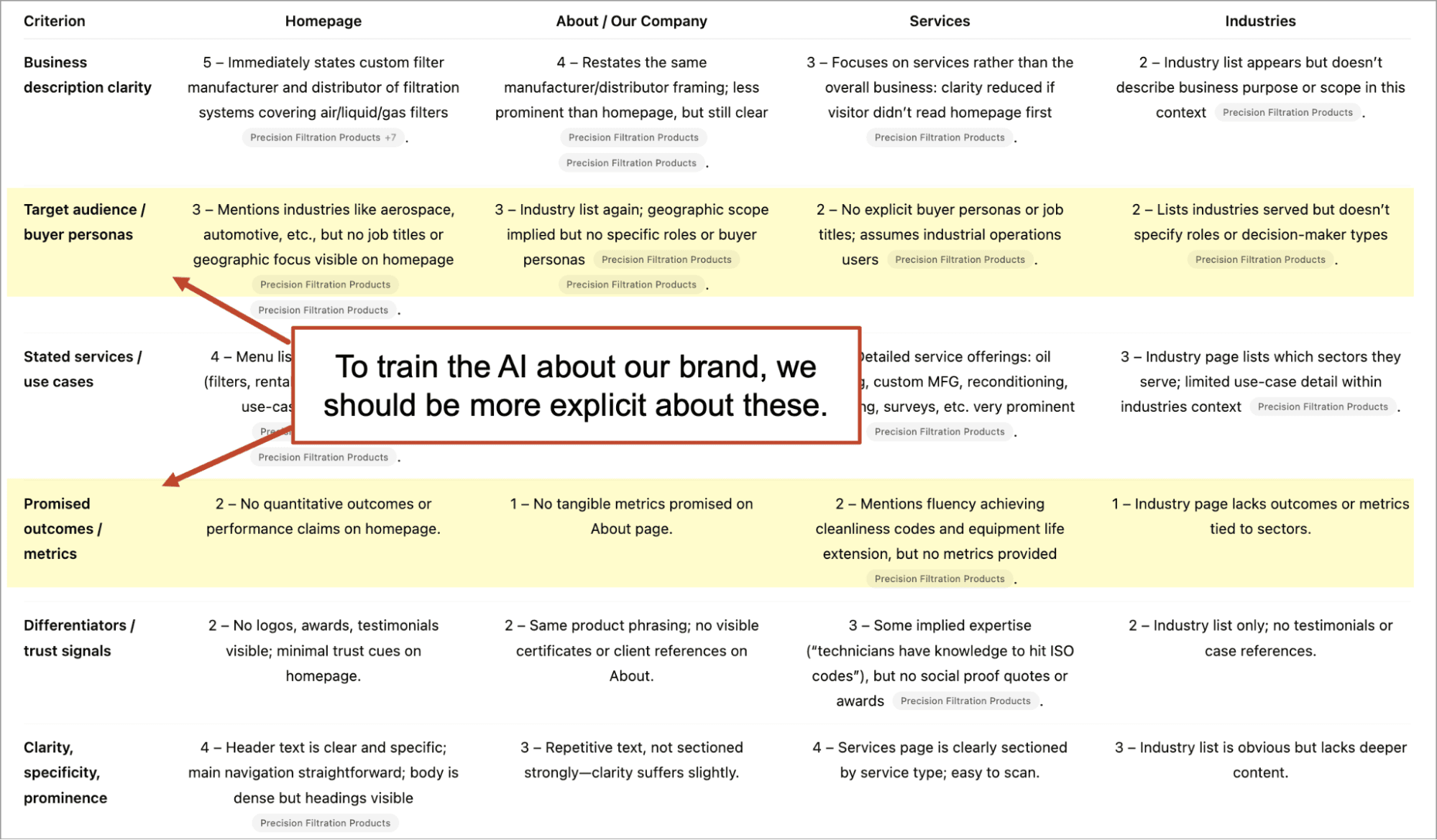 Your own website is the foundation. It’s the first and most important source of AI training data for your brand. The remedies are easy because you control your website. You can change it anytime. Digital ink is never dry.
Your own website is the foundation. It’s the first and most important source of AI training data for your brand. The remedies are easy because you control your website. You can change it anytime. Digital ink is never dry.
If you’re an SEO, set aside the idea of keywords for a moment. This is more like conversion copywriting, where your goal is to help visitors qualify or disqualify themselves. Add answers to questions asked during a sales conversation. You are training the AI to act as a sales rep for your brand.
If conversion is about humans and SEO is about bots, AI sits somewhere in the middle. It learns on stories, like humans, but still relies on a crawler, like Google. Before we move on from on-site AIO, here are a few technical considerations familiar to anyone who knows technical SEO:
- Don’t block AI bots and agents. If you use Cloudflare, you may need to change a few settings. Ask your web partner. (don’t worry about robots.txt of llms.txt because they don’t matter yet)
- AI bots don’t see your images. Does your site have a lot of image-based trust seals (logos, certifications, awards)? Keep in mind that AI bots don’t see them. They aren’t rendering the page and looking at the images. Consider listing these as text near those images so the AI can read about them and add the info to its training data.
- Considering adding schema tags. AI bots may use schema markup to better understand the page. But even if they don’t, considering all possible schemas will push you to make a more comprehensive page.
2. AI Perception Competitive analysis
Now we’ll review your website in the context of the other providers in your vertical. Your future prospect may not yet be brand aware. They may be asking AI to recommend several options. AI may be generating a comparison table.
Open a new chat with whichever LLM your next client is likely to use. Pretend to be your future ideal client. Tell it about your problem, your goals and the type of service you’re looking for. Now you’re seeing what your future prospect sees when they use AI to research options. Are you in the mix?
Let’s do it again, but with more structure and with a prompt that will make sure you’re included. Copy and paste this prompt, replacing the elements that are in brackets.
I’m a [job title] looking for [service provider]. We need [specific service or solution] that can [requirements and specs]. Our goal is [problem to be solved]. Who offers these services products with [key decision criteria]?
Present the output as a table with each supplier as a row. Include [your brand] in the mix.
Format the response as a 4-column table: Provider, Summary, Strengths, Weaknesses.
If you don’t know the specific needs of your prospects, you have a more fundamental marketing challenge! You need to go back, talk to your sales reps and do your research. At the very least, have AI help you build a persona.

Now you know how AI understands you in the context of your competitors. If you spot any gaps in your positioning, you can address them on your website with clear, accurate statements and strong evidence. This is the foundation of AI optimization.
ProTip: Ask AI to convert the comparison table into a buyer guide, polish it up and publish it at the bottom of a key page on your website. This combines buyer’s needs (persona details) with AI-generated insights (competitive analysis) to create new content that helps you appear in AI responses (AI training data).
Where AI thinks you’re weak and they’re strong.
- Highlight those capabilities on your about page (and LinkedIn page)
- Support the relevant claims with strong supportive evidence (testimonials, data, case studies)
- Publish articles showing deep expertise on the related topics
This is where your content marketing program comes in. Brands with active content programs have an edge, because all that content is ingested by language models.
There is no doubt that LLMs are reading company blogs. In fact, more than one-third of the citations in AI responses are to company blogs, according to MuckRack’s analysis of one million AI citations. MuckRack reported on the importance of earned media. But look at the prevalence of owned media and blogs in the percentage of citations:
![]()
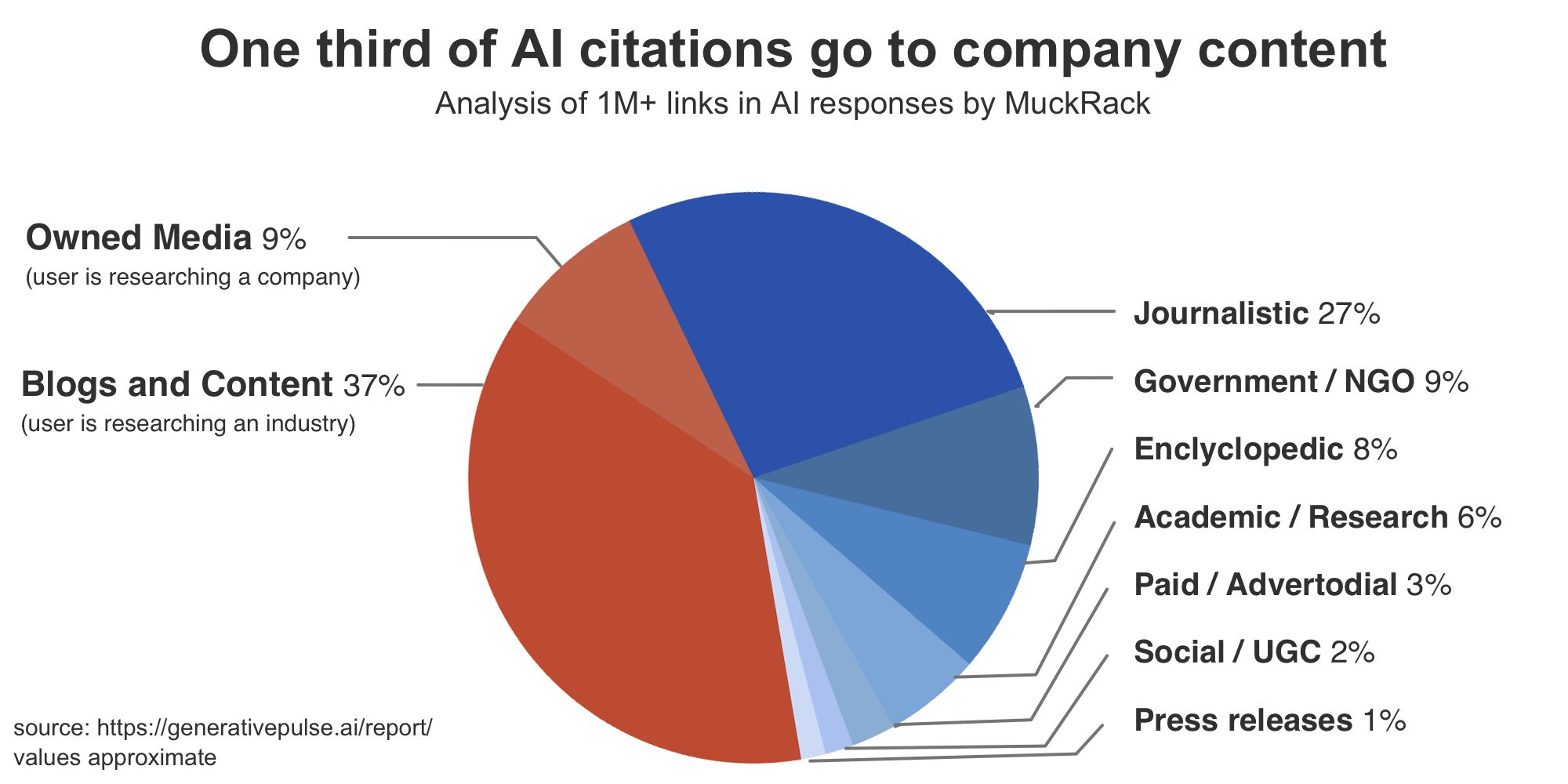 If you have a mature content program, you’re already getting traffic from AI sources. You can see AI traffic in just a few clicks in GA4. But your blog has a new type of visitor, so it has new importance. AI is training on your content and deciding how relevant you are when your buyer asks it questions.
If you have a mature content program, you’re already getting traffic from AI sources. You can see AI traffic in just a few clicks in GA4. But your blog has a new type of visitor, so it has new importance. AI is training on your content and deciding how relevant you are when your buyer asks it questions.
How does a content strategist adapt? It may be just a few adjustments. Here are five prioritized content strategy adaptations that can improve AI visibility.
- Write more case studies with more depth and data about the problems you solve.
- Create a news section and fill it with a steady stream of AI-friendly press releases.
- Publish comparison pages and buyer guides that help prospects consider your brand as an option.
- Build relationships with influencers in your niche. Co-create and co-promote content.
- Do something really big. Do things AI can’t do: take a stand or conduct new research.
Content marketing remains, as always, a long game. And in itself, is rarely sufficient to create demand. But it’s more important now than ever. It is your best opportunity to train AI on your brand’s effectiveness, fit and story.
- At this very moment, a potential prospect is asking AI for recommendations. They are reading AI generated summaries and AI overviews with recommendations for partners. Who is AI recommending?
- At this moment, AI is reading thousands of pages and articles in your industry. Is your most relevant story in the training data?
All set? Great. You’ve tuned up your own key pages and dialed in your own content program. Now it’s time to go beyond your website.
3. Off-site AIO
AI isn’t just training on your website. To appear in AI search engine responses, you need to build support on other websites. There must be many places on the web that show what you do and why you’re a great option relative to your competition.
According to this study by Ahrefs, “branded web mentions” is the factor that correlates most with AI visibility. That means mentions of your brand on other websites. The other top factors were links when your brand is the link and searches for your brand.
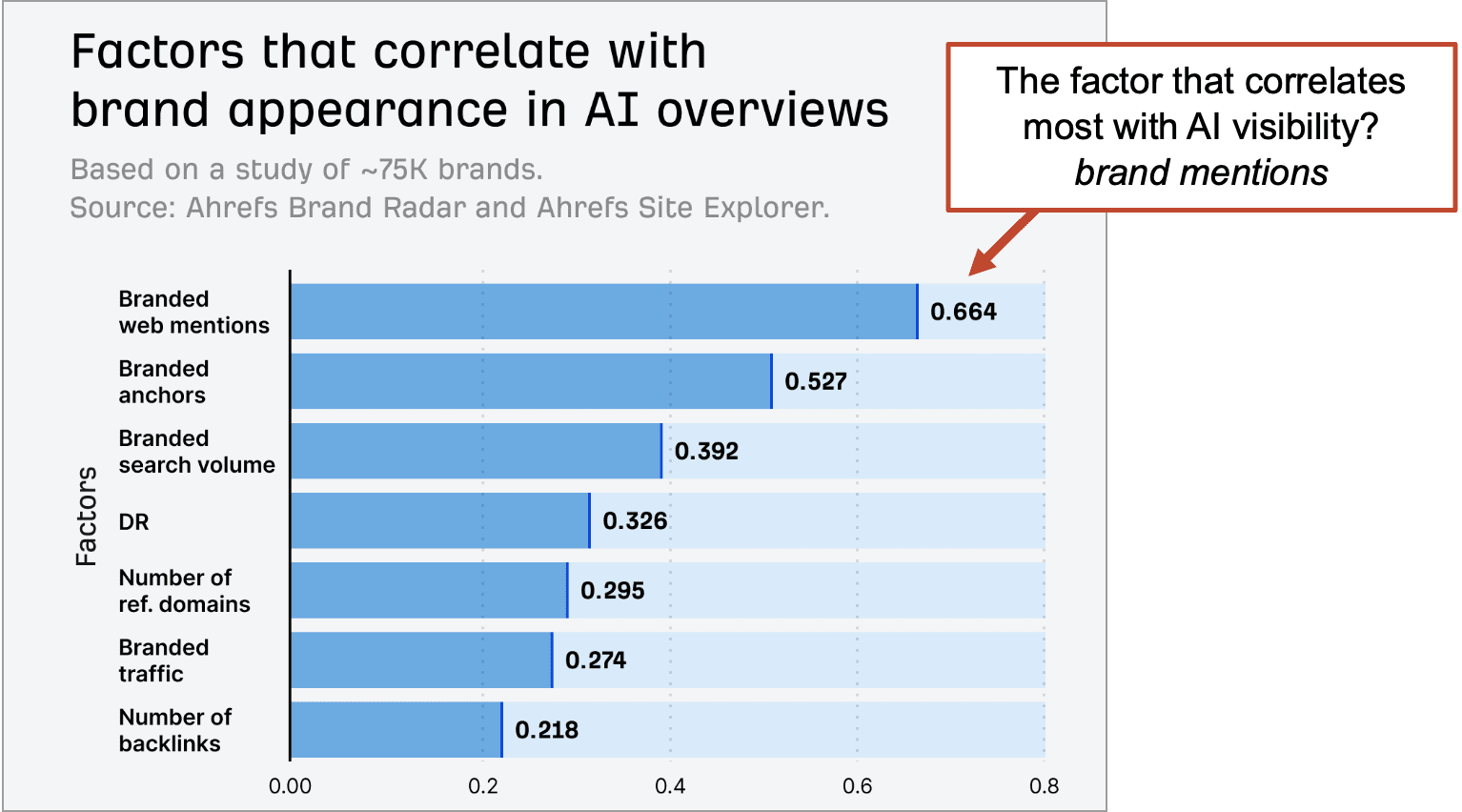
SEOs know that rankings depend on links. AIOs know that AI visibility depends on brand mentions, especially when there is co-occurrence of a brand and the relevant industry terms. The more these appear on the web, the more AI is trained to believe that your brand is relevant for those services. The brand with the biggest digital footprint wins.
How do you win branded web mentions? The short answer is digital PR. Here’s a prioritized list of five off-site actions that can improve AI visibility.
- Confirm that you are in all of the relevant industry directories
- Confirm that you have strong reviews on relevant review platforms
- Collaborate with relevant trade publications, associations and award sites
- Write for publications that your audience reads
- Create buzz that gets you mentioned across the web (strong opinion, original research, bold ideas)
Those first two items are straight digital PR. But the rest of it is really traditional PR. If Ivy Lee, the founder of modern public relations, were still around, he would tell us to focus on the fundamentals: cultivate genuine relationships with editors or deliberately produce newsworthy content. Make friends or make news.
 | Ryan Law, Ahrefs“Unlinked mentions—text written about your brand on other websites—have very little impact on SEO, but a much bigger impact on GEO… LLMs derive their understanding of a brand’s authority from words on the page, from the prevalence of particular words, the co-occurrence of different terms and topics, and the context in which those words are used.” |
If you know off-site SEO (aka “link building”) this all may sound familiar. The difference is that where Google cares about links, AI simply trains on language.
Next, do another type of competitive analysis, but this time for AI training data sources. Fire up any of the AI models, pick a competitor and ask what it knows about them. You’re not asking because you want to see what it thinks of them; you’re asking because you want to discover where it is learning about them.
Here are the two AI Source Competitive Analysis Prompts that will show you where AI is training on your competitors.
What do you know about [competitor]? Besides their website, where did you get this information?
And then…
What other sources provide information about [competitor]? Create a table with at least 10 rows, one for each source you’ve learned and columns showing the type of information provided and the usefulness of each source in research.
You’re now looking at a list of the sources where AI learns about companies in your vertical and the relative importance of each. Probably, you’re seeing business profiles, directory listings, review websites, industry blogs, media sites, trade publications and associations.
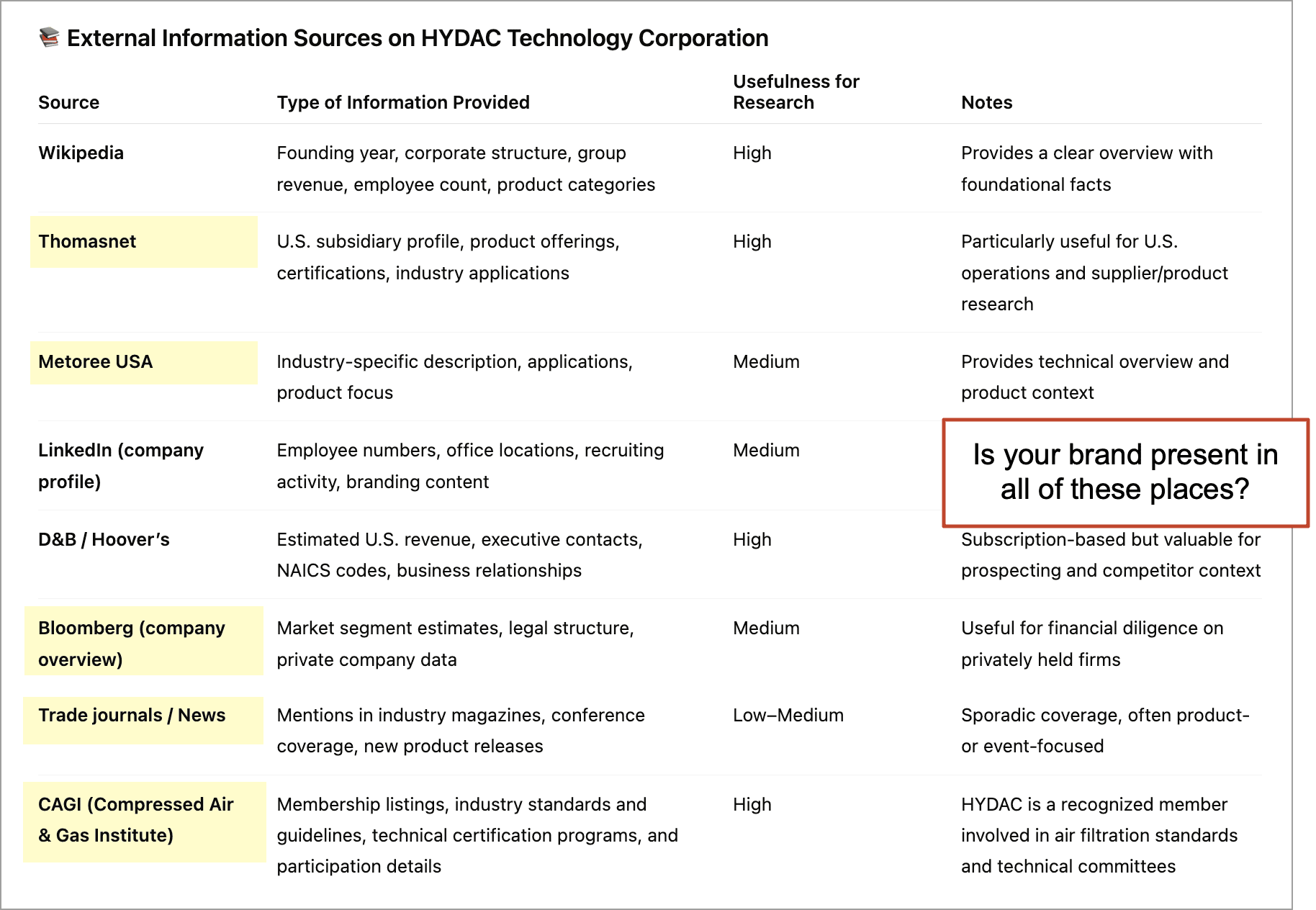
Consider the visibility of your brand in those places, just as you would with local SEO. Are you relevant in the places that AI uses in its knowledge sources? If not, get active getting the basics of your brand in those places. Your goal is inclusion.
More instances of your brand with the adjacent industry terms mean a better likelihood that the AI considers your brand in its responses. That means press releases, LinkedIn company pages, supplier databases and even job postings. Anything that’s on the public internet.
ProTip: AI trains on everything, including transcripts. So go on podcasts and participate in webinars. When you do give a quick elevator pitch. Briefly say what you do, whom you do it for and how it makes a difference.
Here’s an example from a recent article I contributed to for a media site. See how the brand is adjacent to the brand category? That gets ingested by the AI and trains it on what Orbit Media does.
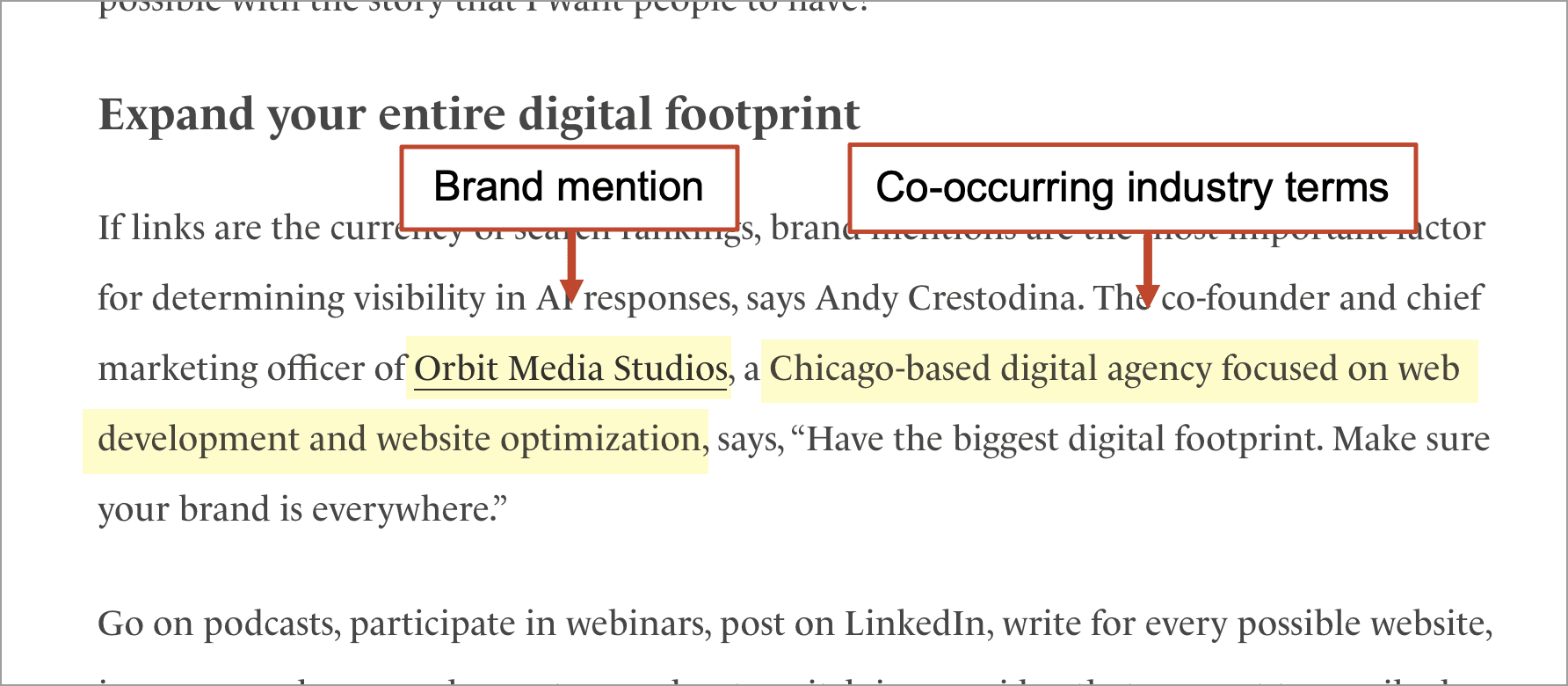
That’s the basics. But the expert AI optimizers of the future will go far beyond earned media with these little brand words and phrases.
If you win 10 branded mentions every month, but they are just little phrases, that may be only a few hundred words total. That probably isn’t sufficient to train the AI that you’re a great option. Detailed stories that connect your brand to results will make a bigger impact. Therefore, columnists for relevant media sites will have an edge.
Think about how AI learns: through exposure, repetition and association. The more often your brand appears in relevant, credible contexts with clear actions and outcomes, the more likely it is to be included in AI-generated responses.
AI optimization is word of mouth marketing, powered by PR and supported with exquisite website detail.
Final recommendations
The AI hype cycle is off-the-charts. The AI evangelists will tell you this is all entirely new. Others say this is no different from what marketing has always been. Whether you think of generative AI tools as new AI search engines or think of traditional search engines and Google’s AI overviews as AI-driven search, the question is what to do next.
Everyone is trying to adapt in different ways.
- Marketers, starting with SEOs, will try to find ways to do this at scale.
- Content marketers and PR pros will (and should) add “AI optimization” to their pitches.
- Agencies will try to create systems for this, and make those systems fit for all their clients.
- Tech companies will try to build tools that report and make recommendations.
But what should we all do today? But don’t wait until the playbooks are published. Don’t try to automate until you’ve done things by hand.
Slow down. Think about your buyer and your brand position. Who is the best fit? What information do they need? How are they doing their research?
Next, think of your marketing strategy. Are you answering their key questions on your website? Am I present in the places where they are doing their research?
AI visibility is built on marketing basics. Confirm those are in place first. Then, adapt to the new context by enhancing and expanding your message and your reach.
- Audit your key pages for specificity, clarity, and role-relevant messaging.
- Publish content on your site that matches real commercial-intent prompts and user queries.
- Confirm you are visible in directories, review sites, awards and associations.
- Feed the AI with guest posts, press releases and transcribed media.
- Test prompts regularly to see how you appear and how others are mentioned.
- Accept volatility and ambiguity: Experiment, expect changes and instability in AI responses.
- Push hard early because this is not the time to wait. Invest in your site, your content and PR.
 Final caution: Do not set aside traditional SEO. Google is still 373x more popular than chatbots. Keep optimizing for traditional search, starting with those “visit-website intent” keyphrases. And most of the recommendations here will improve your visibility in traditional search!
Final caution: Do not set aside traditional SEO. Google is still 373x more popular than chatbots. Keep optimizing for traditional search, starting with those “visit-website intent” keyphrases. And most of the recommendations here will improve your visibility in traditional search!

